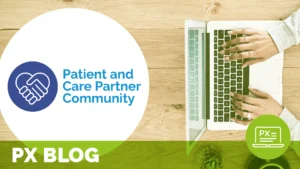Patient, Family & Community Engagement: 4 Ways to Promote Co-Design

This is the first blog in a series of eight by The Beryl Institute’s Global Patient & Family Advisory Board (GPFAB). The intent of this series is to present our perspective on patients’ and families’ lived experience for each of the strategic lenses of The Beryl Institute’s Experience Framework. The Experience Framework is a community-developed tool that acknowledges the integrated nature of healthcare experience and is comprised of eight strategic lenses that help shape patient experience efforts.
Patient, Family & Community Engagement: The “Why”
Central to any experience effort are the voices of, contributions from, and partnerships with those receiving care and the community served.
Impact Statement
When the experiences of patients and families are included in an organization’s processes and executive leadership strategies, patients and families feel respected and valued as an integral part of their healthcare team and as change-agents for the organization.
Commentary
The Patient & Family Impact Statement holds the premise that to achieve this impact patients and families must be actively involved in presenting their lived-experience voices and contributions to the healthcare community where they receive care. The purpose is to effect the right change in healthcare organizations’ processes and executive leadership strategies to achieve the best in patient experience. If done correctly, as the statement says, “patients and families will feel respected as an integral part of the healthcare team.”
It is well understood that a higher level of patient experience drives outcomes and improves the trust that patients and families have with their healthcare community. It can also drive the trust that the healthcare community has with patients and families.
So, how can patients and families best express their lived experience to impact the patient experience? I strongly believe that the healthcare community must establish or create an operating model in which patients and families are given the opportunity to directly co-design with hospital staff. Patient experience strategies, processes and other operating activities will be impacted through this co-design approach.
With co-design as my “guiding principle,” there are four key approaches the healthcare community can consider to engage patients and families:
- Build and sustain an operating Patient & Family Advisory Council (PFAC)
Fundamental in seeking patient and families’ voices is to have a formal operating model that pro-actively seeks out these voices. Building and sustaining a PFAC provides the healthcare community with this opportunity. If the PFAC is operating correctly through a formal charter and structure, it becomes a powerful voice that can directly help co-design patient experience efforts. Key to the PFAC’s success is the commitment and support of the healthcare organization’s CEO and leadership team.
- Include The Beryl Institute’s “The New Existence: A Framework for Action” in your strategy
Another excellent way to listen to and incorporate the voices of patients and families is to tap into the Core Segments and Key Aims of The New Existence framework. One key example is the “Care Teams” segment in which the patient and their circle of support play a key role on care teams. Here, patient and family voices are directly engaged in their care. Another key example would be in “Models of Care & Operations.” In this core segment, the fundamental guiding principle calls for “co-designing systems, processes and behaviors to deliver the best human experience.”
- Engage patients and families directly in the healthcare community’s outreach programs
This can be another powerful way that patients’ and families’ voices can effectively help their healthcare community. Having patients and families share their lived experiences with the healthcare community and seeking out other’s experiences are likely to expand co-design efforts.
- Engage patients and families in the training of healthcare providers and staff through storytelling
Hearing a patient or family member’s personal story directly can impact a provider or staff person and influence how they conduct their future patient interactions. It can also directly impact policy and process changes for such things as safety and quality. Storytelling is a powerful patient and family tool that allows them to share their lived experience and get their voices heard.
The Patient, Family & Community Engagement Strategic Lens of the Experience Framework is foundational to improving the human experience in healthcare. These four ways of engaging healthcare professionals, patients, families and communities to co-design workflows will promote the partnerships needed to use the lived experiences of patients and families to impact experience improvement.
About the author
Tony Serge spent over twelve years as a care partner, during which time he found his passion as a Patient & Family Advisor. Tony is dedicated to sharing the importance and impact of the patient and care partner experience with others, and he pays forward his passion through speaking at Patient Experience Conferences, training sessions, and fund raisers. Tony is a true leader in this space, currently serving as a co-chair of both of The Beryl Institute’s Global Patient & Family Advisory Board and Brigham and Woman’s Hospital PFAC Leadership Committee and past co-chair of Dana Farber’s Adult Patient & Family Advisory Council.
Related content
-
 Patient Family & Community Engagement
Patient Family & Community EngagementPatient, Family, and Health Professional Perspectives of How Families are Involved in Adult Inpatient Traumatic Brain Injury Rehabilitation
Objective: We aimed to answer the following research question: From the perspectives of patients, family members, and health professionals, how are families involved in the rehabilitation of adult patients with Traumatic Brain Injury at an inpatient Acquired Brain Injury service within an adult rehabilitation centre? Methods: We used an interpretive qualitative approach, from a constructivist view.
Learn more -
 Culture & Leadership | Patient Family & Community Engagement | Quality & Clinical Excellence | Staff & Provider Engagement
Culture & Leadership | Patient Family & Community Engagement | Quality & Clinical Excellence | Staff & Provider EngagementPX Chat – Leading with Equity: DEI & the Patient Experience in Today’s Climate
12pm ET / 11am CT / 10am MT / 9am PT – In a time of heightened political and cultural tension, advancing diversity, equity, and inclusion (DEI) in healthcare is both more critical and more complex than ever. This PX Chat offers a dedicated space for members of The Beryl Institute focused on DEI efforts
Learn more -
 Patient Family & Community Engagement
Patient Family & Community EngagementHope for Healthcare
Members of The Beryl Institute’s Global Patient and Family Advisory Board wish you happy holidays. As 2024 draws to a close, we asked our members to jot down their hopes for healthcare as we welcome the upcoming new year. Tony Serge: My hope for healthcare is for leadership, providers, and staff to work together with
Learn more
